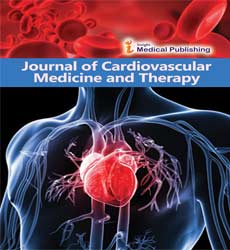Post-COVID 19 Cardiovascular Syndrome: An Entity that Cannot Go Unnoticed in the Post-COVID Era
Maria Paz Bolano Romero1*, Salin David Sanchez-Erazo1, Leidy Angelica Paez-Rincon2, David Alejandro Charry-Borrero3 and Ivan David Lozada-Martinez4
1Department of Medicine, Fundacion Universitaria San Martin, Bogota, Colombia
2Department of Medicine, Universidad Autonoma de Bucaramanga, Bucaramanga, Colombia
3Department of Medicine, Universidad de la Sabana, Chia, Colombia
4Department of Medicine, Surgical Research Center, St Mary’s Medical Group, Cartagena, Colombia
- *Corresponding Author:
- Maria Paz Bolano Romero
Department of Medical and Surgical,
Medical and Surgical Research Center, St Mary’s Medical Group,
Colombia;
E-mail:mbolanor1@unicartagena.edu.co
Received: February 18, 2022, Manuscript No. IPJCMT-22-11457; Editor assigned: February 21, 2022, PreQC No. IPJCMT-22-11457 (PQ); Reviewed: March 07, 2022, QC No. IPJCMT-22-11457; Revised: March 11, 2022, Manuscript No. IPJCMT-22-11457 (R); Published: March 18, 2022, Invoice No. IPJCMT-22-11457
Citation: Romero MPB, Sanchez-Erazo SD, Paez-Rincon LA, Charry-Borrero DA, Lozada-Martinez ID (2022) Post-COVID 19 cardiovascular syndrome: an entity that cannot go unnoticed in the post-COVID era. J Cardiovasc Med Ther Vol:5 No:1
Description
Cardiovascular manifestations and complications of COVID-19 are one of the most important topics in the management of this group of patients, due to the risk of morbidity, mortality and loss of functional capacity [1]. Much of the research on COVID-19 is focused on the acute phase. However, post-COVID 19 syndrome is gaining more and more importance due to the costs and challenges in its management. Post-COVID 19 syndrome is defined as the permanence or genesis of signs and symptoms depending on the organ affected during the acute phase of COVID-19, which may last indefinitely [2]. As this syndrome is characterized according to the organ or organs affected, a large number of phenotypes can occur, the most famous of which is the post-COVID 19 neurological syndrome [3].
Nevertheless, evaluated cohorts report that shortness of breath and fatigue, in both hospitalized and home care patients, and in both those with and without comorbidities, are the most prevalent symptoms over a time span of up to 6 months [1,4]. However, these squeal are more intense and last longer in those with a personal history of pulmonary or cardiac disease [4]. Considering that myocardial injury has been reported in the COVID-19 patient, which may be mild and undetectable in the vast majority of cases (since there are asymptomatic patients who may debut with a cardiovascular events), these symptoms may originate from cardiac decompensating.
Drakes, et al. conducted a study where they evaluated the level of coronary micro vascular injury in patients who had COVID-19 vs. control groups through cardiovascular magnetic resonance imaging, showing that patients who had COVID-19 had significantly reduced global myocardial perfusion reserve (2.73 (2.10-4.15-11) vs. 4.82 (3.70-6. 68), p=0.005), significantly increased coronary sinus flow at rest (1.78 ml/min (1.19-2.23 ml/min) vs. 1.14 ml/min (0.91-1.32 ml/min), p=0.048), and reduced coronary sinus flow during stress activity (3.33 ml/min (2.76-4.20 ml/min) vs. 5.32 ml/min (3.66-5.52 ml/min), p=0.05), compared to controls [5]. These results allowed the authors to conclude that myocardial vascular injury is evident during the post-COVID phase, and probably this pathophysiological micro vascular mechanism is responsible for dyspnea and fatigue during the post-COVID 19 syndrome [5-7].
Conclusion
The use of pharmacological products aimed at improving endothelial function, systemic microcirculation and management of fatigue and dyspnea symptoms during the post- COVID 19 syndrome has also been evaluated, observing a positive response compared to control groups (p<0.05).Given this volume of evidence, we propose for the first time the specific use of the post-COVID 19 cardiovascular syndrome, to target those patients who persist with equivalent cardiovascular symptoms after the acute phase of COVID-19, to evaluate more precisely the coronary endothelial and cardiac micro vascular compromise, to prevent and manage cardiovascular complications, reduce costs, control morbidity, mortality and try to recover and maintain the functional capacity of these patients; mainly those with cardio metabolic comorbidities such as hypertension, type II diabetes mellitus, obesity, or cardiac antecedents such as heart failure, who are at higher risk of decompensating and/or major cardiovascular events. Likewise, to propose strategies aimed at cardiovascular rehabilitation with access to specialized health services that provide strict longterm follow-up.
References
- Lozada Martinez ID, Torres-Llinas DM, Moscote-Salazar LR (2021) Myocardial lesion in patients with COVID-19: Not all is in the lung. J Taibah Univ Med Sci. 16(2):303-304.
[Crossref] [Google Scholar] [PubMed]
- Chippa V, Aleem A, Anjum F (2021) Post Acute Coronavirus (COVID-19) Syndrome. 2021 Jun 4 In: StatPearls [Internet]. Treasure Island (FL): StatPearls Publishing.
[Google Scholar] [PubMed]
- Camargo-Martinez W, Lozada-Martinez I, Escobar-Collazos A, Navarro-Coronado A, Moscote-Salazar L, et al. (2021)Post-COVID 19 neurological syndrome: Implications for sequelae's treatment. J Clin Neurosci 88:219-225.
[Crossref] [Google Scholar] [PubMed]
- Augustin M, Schommers P, Stecher M, Dewald F, Gieselmann L, et al. (2021) Post-COVID syndrome in non-hospitalised patients with COVID-19: a longitudinal prospective cohort study. Lancet Reg Health Eur 6:100-122.
[Crossref] [Google Scholar] [PubMed]
- Drakos S, Chatzantonis G, Bietenbeck M, Evers G, Schulze AB, et al. (2021) A cardiovascular magnetic resonance imaging-based pilot study to assess coronary microvascular disease in COVID-19 patients. Sci Rep 11(1):15667.
[Crossref] [Google Scholar] [PubMed]
- Belcaro G, Cornelli U, Cesarone MR, Scipione C, Scipione V, et al. (2021) Preventive effects of Pycnogenol on cardiovascular risk factors (including endothelial function) and microcirculation in subjects recovering from coronavirus disease 2019 (COVID-19). Minerva Med.
[Crossref] [Google Scholar] [PubMed]
- Calabrese M, Garofano M, Palumbo R, Di Pietro P, Izzo C, et al. (2021) Exercise Training and Cardiac Rehabilitation in COVID-19 Patients with Cardiovascular Complications: State of Art. Life (Basel). 11(3):259.
[Crossref] [Google Scholar] [PubMed]
Open Access Journals
- Aquaculture & Veterinary Science
- Chemistry & Chemical Sciences
- Clinical Sciences
- Engineering
- General Science
- Genetics & Molecular Biology
- Health Care & Nursing
- Immunology & Microbiology
- Materials Science
- Mathematics & Physics
- Medical Sciences
- Neurology & Psychiatry
- Oncology & Cancer Science
- Pharmaceutical Sciences
